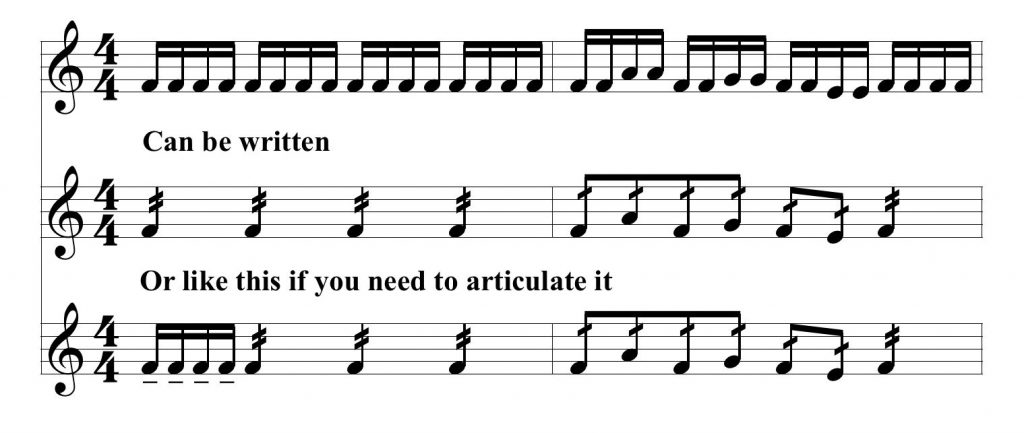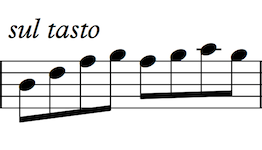Two of the most misinterpreted markings, the Martele and Marcato both imply strong accents. A quick search on the internet will reveal differing and often contradicting information about these two. The orchestrator/composer is advised to mark the passage with text "Martele" in addition to the graphic symbol. Marcato is a general term that can be applied to any instrument. It indicates that a note is to be played louder or more forcefully than surrounding music. It implies an accent of greater force. Martele is a term used to define a string instrument bow stroke. It is a type of Marcato that is specific to strings. The martele literally means "hammered" and starts with a bold heavier attack, rapidly dying away with a gap before the next note. Marcato is a stroke where the bow does not leave the string in between notes and therefore is classified as a staccato bowing (Adler Movie: martele) (Alder Audio 1-22) a. Heavier strike. "Hammered" b. Often marked with "wedge", "hat" & accent Note the book does not distinguish markings
OFF THE STRING BOWING1. Spiccato- Conscious (Adler
Movie: Conscious Spiccaato)
2. Spiccato- Spontaneous = "Saltando"
(Adler Movie: Spontaneous
Spiccaato)(Alder Audio 1-24) 3. Spiccato- Slurred (Adler
Movie: Slurred Spiccaato) (Alder Audio 1-25) 4. Jete- "Ricochet" (Adler
Movie: Jete)
(Philharmonia Movie Jete)(Alder Audio 1-27)
5. Arpeggiando- (Adler
Movie: Arpeggiando)(Alder
Audio 1-28) TRILLS AND BOWED COLOR EFFECTS1. Trills(Adler
Movie: Trill) (Alder Audio 1-29) 2. Bowed Tremolo- (Adler
Movie: Bowed Tremolo) Berlioz Symphonie
Fantastique II A Ball 3. Fingered Tremolo- (Adler
Movie: Fingered Tremolo)(Alder Audio 1-31) Berlioz
Symphonie Fantastique II A Ball 4. Measured Tremolo |
||||||||||||||||||||||||||||||||||||||||||||||||||||||||||||||||
| Sul Tasto |
7. Flautando

Use Text Marking "Flautando"
a. Literally means "Flute-ing" or "Flutey" This type of bowing
produces a light and airy sound and is produced by moving slightly sul
tasto and bowing very rapidly so that the string does not have a chance
to vibrate to full fruition. Although the bow is moving fast, it does
not necessarily have to be loud. Can be combined with other bowed
techniques.
|
Flautando
|
NOTE: Flautando must be written. To return to normal use "Ord" or "Normale"
8. Sul Pont.
- (Adler
Movie: Sul Ponticello) Philharmonia Movie Sul Pont
La Mer Mvt III Rehearsal 45.
Approx 01.00
Use Text Marking "Sul Pont."
a. Literally means "On the Bridge". HOWEVER: Sul Ponticello is played
close to the bridge but not literally on it. If you want the player to
play on the bridge you should not use Sul Pont. Errie, glassy-soft,
brazen-loud as you get closer to the bridge. Note diff. btwn solo and
ensemb.
| Sul Ponticello |
9. Col Legno.
-(Alder
Audio 1-36-37) Philharmonia Movie collegno.mov
Use Text Marking "Col Legno"
a. "with the wood" of the bow
i. Battuto = hit (Adler Movie: Col
Legno Battuto )
ii. Tratto = bowed (Adler Movie: Col
Legno Tratto )
Note: Can be devoid of Pitch and very soft.
NOTE: Sul Tasto, Sul Pont, & Col Legno must be written. To return to normal use "Ord" or "Normale"
NON BOWED COLOR EFFECTS
1. Pizzicato.
- (Adler Movie: Pizzicato) (Adler Audio1-38)
a. Thickness of string important.
b. Not as much time needed as you might think to set up.
| Pizzicato |
2. LH Pizz
- (Philharmonia
Movie LH Pizz )
a. most successful on open string while RH is bowing
3. Snap (Bartok) & Fingernail Pizz

(Adler Movie: snap pizz) (Adler
Audio 1-40)
a. Show marking.
4. Pizz Chords
(Adler
Movie Pizz Chords) (Adler Audio 1-41)
a. Most often are strummed like a guitar although simple chords can be
played as a single simultaneous execution. Use the "pizz" designation
with an arrow on the chord to show the direction of the strum.
b. Same guidelines as multi stops but not as broken on trip and quads
Note: Must state "Arco" when returning to
bow.
1. Mutes (Con Sordino)

(Adler
Movie: Mutes) (Adler Audio: 1-44)
a. There are two types of mute: the wooden mute, which is placed on the
bridge, and the sliding plastic mute, which is permanently attached to
the strings. Be sure to allow sufficient time for the player tp put on
or take off a mute!
b. The sliding mute is most common and goes on/off quickly
Note: must state "Senza Sord." when
finished
SCORDATURA
1. Scordatura = alternate tuning of
strings (Alder Audio 1-46)
a. must give to player before performance
b. "cheap fiddle" sound
c. Problem retuning quickly with ensemble
HARMONICS

La Mer Mvt III 5 bars after
54. Approx 4:00
Scheherazade Mvt II Vivace Scherzando
1. Natural Harmonics
"Smooth Glassy Sound" (Adler Movie: Natural
Harmonics)
a. Harmonics represent the other pitches or "overtones" present in
every note. Overtones give color
b. To be safe, dont go beyond 5th partial.
c. Must specify string on which harmonic is played (ie Sul G or IV on
Violin)
d. Most common notation is a little circle above the SOUNDING pitch.
| Harmonic Series or "Partial" | Node Placement from Nut or Bridge | Sounding |
| 1st "fundamental" | Open string | Unison |
| 2nd | 1/2 way | 8va |
| 3rd | 1/3 way | 8va + p5 |
| 4th | 1/4 way | 15ma |
| 5th | 1/5 way | 15ma + M3 |

Violin Natural Harmonics through 6th partial
Note: Whereas it is perfectly acceptable to
be very specific about which partial is to be played via a specific
string, and whereas any of the methods of notation presented in Adler
are fine, it is common practice that the orchestrator or composer
simply write the desired pitch with the "o" denoting that the pitch is
to be produced via a harmonic. The decision how that harmonic will be
produced is then left to the principal of each section.
| Natural Harmonics @0.00 || Artificial Touch 4th Harmonics @2.00 |
2. Artificial Harmonics

"Hazy
Flutey, Silvery Sound" (Adler Movie: Artificial
Harmonics) Philharmonia Movie artharmvib.mov (Adler Audio 1-48,49,50)
a. Produced by "Touch 4th" or stopping the
desired pitch with the first finger and lightly touching the string a
P4th above with the fourth finger.
b. Always produces a sound 15ma
c. Avoid on Contrabass
d. Notate as normal stopped pitch with diamond "touched 4th" above :
Show notation
e. Range limit is about P5 above the top string (sounding 15ma + P5
higher than top string)
f. Avoid using the little "o" above sounding pitch to denote an
artifical harmonic. Other methods of producing artifical harmonics are
available and it can be confused with natural harmonics.
3. Contemporary Techniques (play
Threnody by Penderecki look at score)
a. Tapping and slapping, behind the bridge, wide vibrato, highest possible
note, wrong side bowing, microtones, bowing the tailpiece
b. Its fair to ask anything and you can invent notation but you must
specify in score
c. Dont do anything that could damage instrument.
d. Show notation chart Contemp.pdf
4. Combinations of Techniques
a. Think about what the play is
physically doing
b. Gliss + Pizz, Gliss + Sul Tasto, Gliss + Sul Pont., Pizz behind
bridge, Gliss + harmonics etc....













